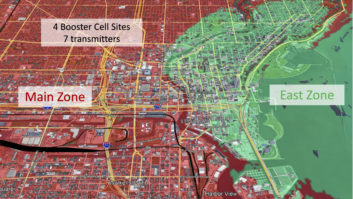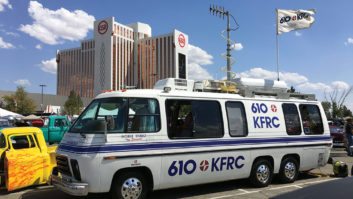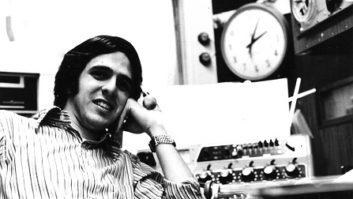Paul McLane is U.S. editor in chief.
Kudos to the FCC Media Bureau, which has decided it will allow U.S. AM stations to use technologies that reduce transmitter power consumption — techniques that have been available to broadcasters elsewhere for years.
In the United States, Nautel and Harris offer such technology for AM use, and Nautel’s Tim Hardy has been a vocal proponent in recent years. Radio World has reported on interest in the issue. Alaska Public Broadcasting Inc. Director of Engineering Chuck Lakaytishas been particularly active in exploring this and spoke about his experience at the spring NAB Show, so AM owners probably owe him a particular “thank you” right now (or maybe a penny for each dollar saved on their power bills!).
Stations will still need a waiver of rules to proceed, but the bureau has set up procedures to seek the waiver, and it indicated it would approve requests that use the Nautel and Harris options.
“Such technologies, known generally as Modulation-Dependent Carrier Level control technologies or algorithms, have long been used by international broadcasters operating high-powered AM transmitters,” the FCC staff wrote. “Easier implementation of MDCL algorithms and higher energy costs have recently made these techniques more attractive to domestic broadcasters.”
The amount of energy savings depends on various factors, but the FCC said that in typical cases, power consumption of an AM transmitter can be reduced by 20 to 40 percent. Tim Hardy at Nautel was quoted by RW’s Leslie Stimson earlier this year saying, “It would be fairly easy to save $20,000 a year if you have a 50 kW AM transmitter running 24/7, based on modest electricity rates of 10 cents per kilowatt hour.”
The Media Bureau in its announcement offered a short history, noting that in the 1980s, European entities like the BBC, AEG Telefunken and ABB Group developed algorithms to reduce power consumption by radio transmitters.
“These algorithms, known variously as Dynamic Amplitude Modulation, Amplitude Modulation Companding, Adaptive Carrier Control or Dynamic Carrier Control, decrease carrier power by amounts up to 6 dB, with the power reductions applied at different modulation levels depending on the algorithm.”
In the U.S., Harris offers Amplitude Modulation Companding (AMC) and Adaptive Carrier Control (ACC) features for its AM transmitters, and can add the feature to some older transmitters. Nautel includes an option, Dynamic Carrier Control (DCC), on NX series transmitters, and can install it on other models. The FCC said it will consider waiver requests for implementation using other transmitters, if any come forward.
The commission staff noted that the reduction in AM signal power at certain modulation levels “inevitably exacts some penalty upon audio quality. Depending on the content of the audio program, MDCL algorithms may introduce some audio distortion or may decrease the signal-to-noise ratio in the receiver.” They may also erode coverage slightly at the fringes of your protected service area. “Both the long experience of transmitter manufacturers and broadcasters abroad, and the initial reports from experimental operations in Alaska, however, indicate that such adverse effects are generally imperceptible.”
The FCC also noted that field strength readings could be affected, so it encouraged stations to disable the technology before doing field strength measurements. “We expect licensees to cooperate with field strength measurement programs by other stations.” It also said it would allow AM stations broadcasting IBOC to implement the technology if the hybrid signal continues to comply with spectral emissions mask requirements and the relative level of the analog signal to the digital signal remains constant.
AM stations that want to implement the technology should send a letter requesting a waiver of Section 73.1560(a) of the Rules, addressed to:
MDCL Waivers
Federal Communications Commission
Audio Division, Media Bureau
445 12th Street SW, Room 2-B450
Washington, DC 20554
The FCC said applicants should also email a copy to [email protected].
The letter should spell out which technology you plan to use and how it will be implemented. If approved, the division will issue a modified station license indicating that a waiver has been granted to permit use of a specific MDCL technology, resulting in the variation of transmitter power to levels below 90 percent of the station’s nominal licensed power.
But note, the FCC will still require that your transmitter achieve full licensed power at some audio input level, or when the MDCL is disabled temporarily. “This requirement will permit stations to use energy-saving MDCL technologies, which preserve licensed coverage areas, while distinguishing between such operations and simple reductions in transmitter power, which do not.” It said it will also continue to authorize operations for stations that want to evaluate MDCL technology. Those requests require only an informal application, typically a letter.
Good job, FCC. Good job, Chuck Lakaytis, and the folks at the transmitter companies who have been pushing these ideas forward. (There’s a side moral to this story: The private sector can in fact influence regulatory bodies to make productive changes, despite cynicism to the contrary about that — especially if its ideas are put forward with persistence and technical care. Such activism is even more important in an era when the FCC and other regulators may have fewer technical resources on staff. )
For questions about the waiver requests, email [email protected].












